Dec-06-15
 | | Phony Benoni: Some days, it just doesn't pay to come up with a Brilliant Idea. <35.?>

click for larger viewPopiel, a pawn down and even worse off positionally, seeks a swindle and finds one: 35.Rxc6 Rxc6 36.Be5 threatening mate and thus wining the queen. How nice! But Teichmann is a wily devil, so this must be calculated carefully. And Popiel finds the flaw: if 35.Rxc6 Be1! traps the White queen. very unfortunate. But Popiel has a few wiles about him as well, and spies a way that might make his idea work with <35.a3>. The idea is that if Black takes the pawn, his bishop can no longer reach e1 and the original swindle works. Of course Black has several perfectly good responses, but this is Monte Carlo. You gotta press your luck once in a while. And Teichmann falls into the trap with <35...Bxa3>! Happily, Popiel plays <36.Rxc6 Rxc6 37.Be5>. Teichmann shurgs, and continues <37...Qxe5 38.Qxe5 Bd6>. Crap-out. |
|
Apr-21-21
 | | KEG: von Popiel, a lucky winner in the first round at Monte Carlo 1902 (when his opponent resigned in a won position) played Teichmann about even for the first 28 moves. But he blundered on move 29, and Teichmann put him away with dispatch. The game had an amusing finish (well described--with one exception--by <Phony Benoni> on this site). In short, von Popiel--in a lost position--tried a swindle, Teichmann "fell into" it, and then won when the swindle proved to have a vicious hole. 1. e4 e5
2. Nf3 Nf6
3. d4
A popular alternative at the time to 3. Nxe4, It was played in this tournament in the prior round in Napier-Eisenberg, a game won by the former. 3... Nxe4
4. Bd3 d5
5. Nxe5 Nf6
Playable but inferior to 5...Nd7; 5...Bd6; or even 5...Be7 as played in the aforementioned Napier--Eisenberg game. 6. 0-0 Be7
7. c3 0-0
8. Nc3 dxc4
9. Bxc4 Nc6
Teichmann correctly recognized that the isolated doubled c-pawns he gets after von Popiel's next move were more than outweighed by other factors. 10. BxB
10. Be3 was probably better.
10... bxB

click for larger view"Black now has an open file for his rook and a good Bishop pair." (Tournament Book) On balance, and the Tournament Book notwithstanding, White is clearly better. But the quoted assessment of Black's assets are correct, and Teichmann's position definitely gave him possibilities. On the other side, an assessment of White's position depends in part on the age-old issue of the pros and cons of the isolated d-pawn. 11. Be3
11. Re1 or the prophylactic 11. h3 seem better.
11... Nd5
12. Qd3 Rb8
The alert Teichmann looked to exploit the open b-file. 13. b3 Re8
14. Rad1 Bg4
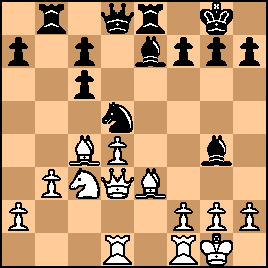
click for larger view15. BxB
This extinguished any edge White still had. It is hard to see why von Popiel gave Teichmann: (1) the advantage of the two Bishops; and (2) a chance to straighten out his shattered Queen-side pawn structure. 15... cxB
16. f3 Bc8
17. Bf4 Rb6
18. Rfe1 Rg6
19. Re5 c6
20. Rde1 Be6

click for larger view21. Rh5
This sortie led nowhere. 21. R5e2 or 21. R5e3 were better. 21... Bb4
22. Re2 h6
A needless (but ultimately unimportant) weakening of the Black King-side fortress. Teichmann could have played 22...Bc8 or 22...Bd7. 23. Na4 Bc8
24. RxR+ QxR
25. Re5
Retreating to the square this Rook had abandoned four moves earlier. This loss of time resulted in a small edge for Black with his two Bishops. 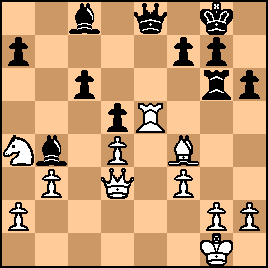
click for larger view |
|
Apr-22-21
 | | KEG: Post II
25... Re6
On its face, this certainly looks inferior to 25...Re6. But that would at best a small advantage. Teichmann, however, seemingly wanted more, and sought complications in the hope that his less experienced (and less talented) opponent would falter. Soon enough, this strategy paid dividends to Teichmann. 26. Re2
von Popiel was initially reluctant to enter the thicket. In fact, he would have the (somewhat) better game with 26. Nc5. 26... Qc8
27. Qe3
"?"--(Tournament Book)
"Increasing the value of the [Black] Bishops. The best was 27. Nc5." (Tournament Book) 27. Nc5 was arguably better, but there was nothing much wrong with the text, the Tournament Book notwithstanding. It was only beginning with his next move that von Popiel got in trouble. 27... Qa6

click for larger view28. Rc2?
This gave Teichmann a chance to gain time with his next move. von Popiel could, however, have pressed Teichmann with 28. Nc5, or just sat pat with 28. Kf2. 28... Bf5!
Teichmann immediately exploited von Popiel's weak 28th move. But his position was not beyond hope---yet: 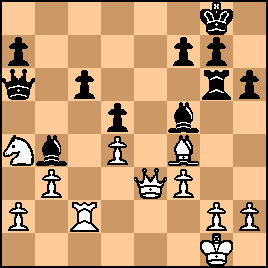
click for larger view29. Rc1?
After this lemon, von Popiel was dead. It was still not too late to try 29. Nc5! (since if 29...BxN 30. RxB Qxa2 31. g4 White would have chances despite his pawn minus. After 29. Rc1?, Teichmann quickly ran von Popiel off the board: 29... Re6!

click for larger view30. Qf2
von Popiel was busted, and the game seemed over. But there was still some excitement to come before the contest came to a close. 30... Re2!

click for larger viewThe game now certainly looked over, but von Popiel decided to embark on a desperate scheme that--as will be seen--momentarily appeared to give him a chance to turn the tide. 31. Qg3?!
31. Qf1 looks most likely to enable White to hold on for a while. But von Popiel preferred to go down fighting. 31... Qd3!
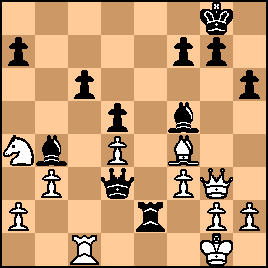
click for larger viewThis now looks like a massacre. But, believe it or not, the main interest of the game was yet to come. |
|
Apr-22-21
 | | KEG: Post III
32. h4
The beginning of a cute but flawed scheme that von Popiel seems to have hatched to save a dead lost position. 32... Qxd4+
33. Kh2

click for larger view33... Re6
The strongest move and quickest way to finish was 33...Qf6. But the text also wins, and allows a remarkable finish. 34. h5
34. Kh1 or 34. Rf1 were maybe theoretically better, but only the text allowed von Popiel to attempt the swindle identified by <Phony Benoni> 34... Kh7
34...g5! would have put an end to von Popiel's fantasies, but the text also wins--and more spectacularly. 35. a3
"?"--(Tournament Book)
The Tournament Book, that probably would prefer 35. Bb8 or 35 Bc7, but the text was far more interesting. <Phony Benoni> says that von Popiel may have originally have planned 35. Rxc6 RxR 36. Be5 threatening both mate and the Black Queen and thus winning, but realized that Teichmann could then have won his Queen with 35...Be1. All true, but this analysis overlooks that--as happened in the game--Teichmann could just have "fallen" into von Popiel's trap with 35...RxR 36. Be5, and then won with 36...QxB! 37. QxQ Bd6 winning back the Queen and leaving Black a Rook ahead. In any case, von Popiel thought to pull off his swindle by getting Teichmann's Bishop away from the diagonal that would allow Be1. But, to quote <Phony Benoni>, Teichmann fell into the "trap" with 35... Bxa3

click for larger viewNow, von Popiel proceeded with his plan:
36. Rxc6 RxR
37. Be5

click for larger viewSo does White now win a Queen because of his threat of Qxg7 mate? Nope. To quote <Phony Benoni> one last time: "Teichmann shrugs and plays": 37... QxB
"!"--(Tournament Book)

click for larger view38. QxQ Bd6
Ouch!
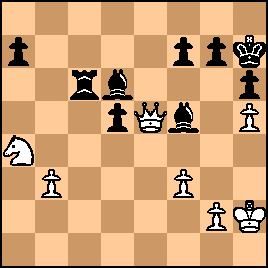
click for larger view0-1 |
|
|
|
|





